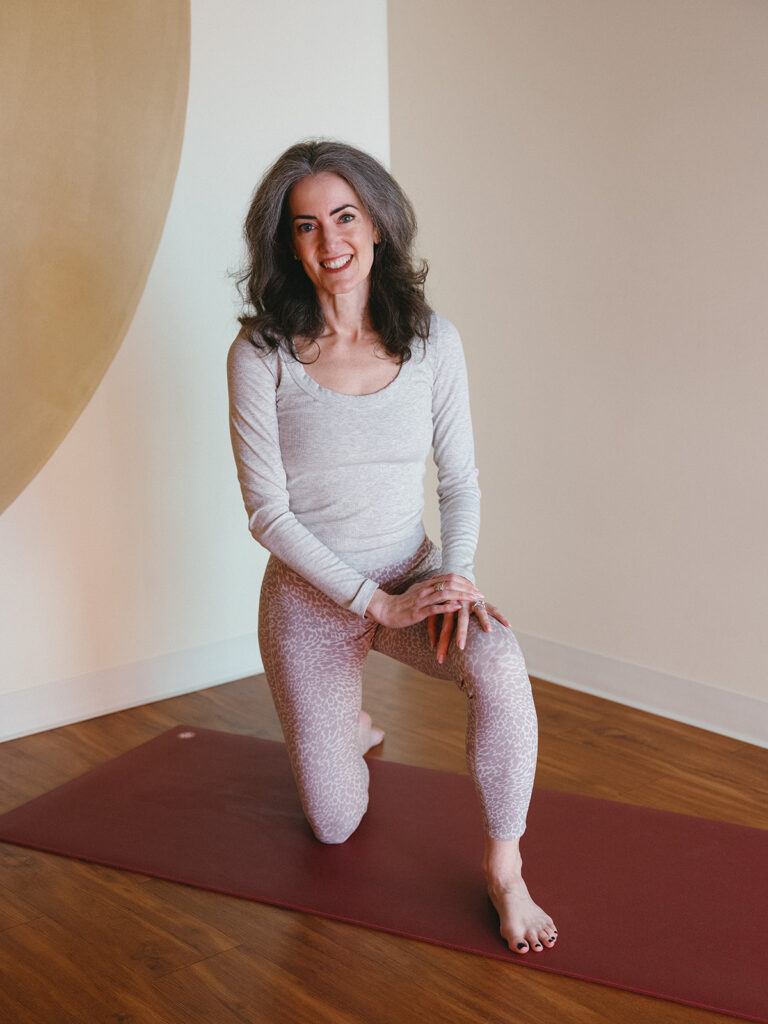Today I was asked why we call hip stretches “hip openers.” I don’t have a good answer! Are we opening something that’s locked? Is “openness” of the hips even desirable, given the stiffness that’s required for good running? I decided that a better term might be “hip balancers,” since there’s so much going on anatomically around the pelvis, and much of our work in yoga is to stretch the tight parts and strengthen the weak parts.
For many of us—not just athletes, but Westerners, who sit in chairs and cars, with our hips and chests closed off under desks and over keyboards and steering wheels—the problem is tightness in the front of the hips, usually in the iliopsoas, the major hip flexors, combined with weakness in the glutes and hamstrings that attach to the back of the pelvis.
Weakness? Indeed. The number-one complaint I hear in yoga class is “my hamstrings are tight.” What do you mean by “tight”? Are they tight because they’re so strong, or are they tight because you spend most of your day with the hamstrings in a state of overstretch? If, when you come into a low crescent lunge, you feel more stretch (or, yes, “opening,” which leads to balance) in the front of the back leg than in the back of the front leg, it may be the latter. In this case, you’ll want to target the hip flexors.
Last week in my yoga for athletes classes, I taught a sequence with a ton of hip-flexor stretches, which got us primed for some nice backbending. (Without that release in the front of the hips, any backbend just crunches the lower back and doesn’t target the thoracic spine.) Here’s what we did (not all of this may be appropriate in your body!):
Supine warm-up
- One knee to chest, releasing the other leg straight along the ground (apanasana)
- Reclining lunge position, bent-leg foot to the sky (half happy baby)
In both, keep reaching through the long leg to target the front of the hip. Next, we flipped over to enjoy six moves of the spine before . . .Main sequence
- Downward-facing dog to three-legged dog, bending raised leg slowly to feel a psoas release
- High lunge
- Low lunge
- Low lunge with closed twist
- Low lunge with reach behind body to quadriceps stretch (i.e., with left leg forward, left hand reaches around to the left to grasp the right foot)
- Crescent lunge with lateral stretch (if leg leg is forward, right arm reaches over left shoulder)
- Low lunge with straight-facing quadriceps stretch (right hand to right foot)
- King Arthur pose (back leg against the wall)
- Bow-pose sequence (as in The Athlete’s Pocket Guide to Yoga)
- Revisited three-legged dog with psoas stretch, flipping to a three-point backbend
Finishing sequence
- Supported bridge with block under hips
- Psoas exercises on the block à la Jill Miller (her Hip Helpers DVD is fabulous)
- Supported fish over two blocks
- Knees-down reclining twist
- Full happy baby
You asked me to email you, so here it is: as measured on an Inspirometer, a simple device that provides a gross measurement of exhalations, my lung capacity increased from 3.0 liters to 3.5 liters as a result of class tonight. It’s not consistent, but most likely could be with time and practice. Very exciting for me as a professional brass player. I have tried many things to increase my lung capacity and have never been able to exhale over 3 liters.

